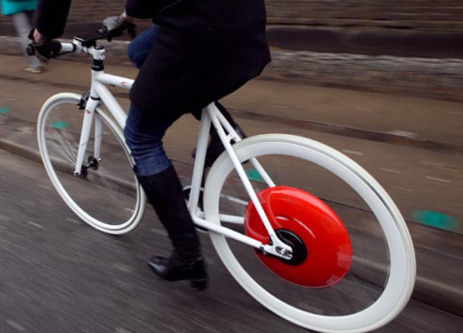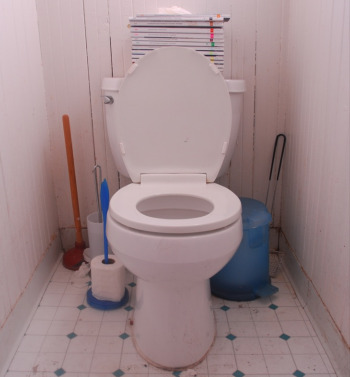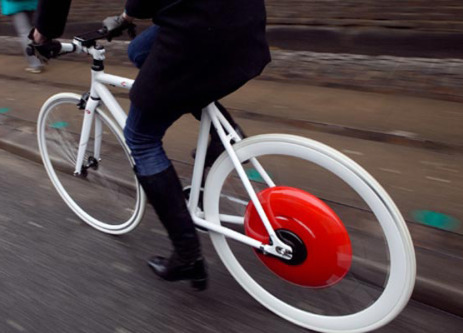What a week. While scientists testifying on Capitol Hill trashed the government’s estimates on how much oil lingers in the Gulf, sound-sensitive munchers everywhere trashed the new compostable Sun Chips bag because it’s louder than a New York subway train. Really. But here’s some under-the-radar items that will provide even more snappy repartee fodder for your weekend social soirees:
 The Copenhagen Wheel.Photo: SENSEable Cities LabThe wheel deal: Hybrid bikes may soon be getting a lot cooler. Using a principle from Formula 1 racing, a team from MIT’s SENSEable Cities Lab is moving forward with an invention they call the Copenhagen Wheel. It’s a device that uses a battery to capture the kinetic energy created whenever you apply the brakes. It then uses that energy to give you a needed surge, say, when you’re pedaling uphill. But the Copenhagen Wheel does more than provide a power boost. Sensors and a Bluetooth connection can tell you, through your iPhone, your speed and distance and even the pollution levels, if you really want to know. Named in honor of the bike-friendly city, the Copenhagen Wheel won the American round of the 2010 James Dyson Award given to top design engineers. The next phase of the competition is next week. David Teeghman shares the details and a video at Discovery News.
The Copenhagen Wheel.Photo: SENSEable Cities LabThe wheel deal: Hybrid bikes may soon be getting a lot cooler. Using a principle from Formula 1 racing, a team from MIT’s SENSEable Cities Lab is moving forward with an invention they call the Copenhagen Wheel. It’s a device that uses a battery to capture the kinetic energy created whenever you apply the brakes. It then uses that energy to give you a needed surge, say, when you’re pedaling uphill. But the Copenhagen Wheel does more than provide a power boost. Sensors and a Bluetooth connection can tell you, through your iPhone, your speed and distance and even the pollution levels, if you really want to know. Named in honor of the bike-friendly city, the Copenhagen Wheel won the American round of the 2010 James Dyson Award given to top design engineers. The next phase of the competition is next week. David Teeghman shares the details and a video at Discovery News.- Bermuda Triangle alert!: You know that “island” of tiny bits of plastic drifting in the Atlantic? The one that stretches from Virginia to Cuba? Well, for 22 years, students working with the Sea Education Association have been dragging fine mesh nets through the Atlantic and analyzing the plastic they captured. A study of that data has led to a startling conclusion — although a lot more plastic has undoubtedly wound up in the ocean during the past two decades, the island has not grown. Several theories have been floated, but no one has a good answer. Emily Sohn lays out the mystery at Discovery News.
- Et tu, Mr. Potato Head?: In a world where everyone talks a good green game, ClimateCounts.org lets us know who’s blowing smoke when it comes to their commitment to sustainability. ClimateCounts’ latest rankings are out, and while almost 60 percent of the 47 firms rated improved their scores from the last report, most were only marginally better. The rankings show the good guys — pharmaceutical firms, believe it or not — and the bad — toy companies continue to underachieve. Get the lowdown from ClimateBiz.
- The simple sun: Finally, solar goes plug and play. A Seattle outfit named Clarian Power has created a portable, DIY solar power generator called the Sunfish. It’s relatively cheap — about $800 per panel — and, in theory at least, as simple as operating a toaster. Find a sunny spot, plug the Sunfish into an outdoor outlet and, if it lives up to the hype, solar power will start flowing into your electrical system. No electrician required. Get the background from Jim Witkin at the New York Times Green blog.
- Battery will get you somewhere: If anything can put the brakes on electric car sales, it’s the cost of batteries. By itself, a battery pack can add $10,000 to the sticker price. But MIT professor Yet-Ming Chiang says he has a concept for a kind of hybrid battery that could cut that cost by as much as 85 percent. If he’s right, Chiang could bring the price of electric cars icloser to what it costs for their gas guzzling cousins. Kevin Bullis tells the story at MIT Technology Review.
- Film ‘er up: The concept of solar paint isn’t new, but a Norwegian firm hopes to take it to the next level. Ensol has patented a spray-on solar film which is composed of metal nanoparticles instead of the standard silicon-based solar cells. Finally, after oh so many years, we can truly empower our windows. Get more from Ben Coxworth at Gizmag.
- Start spreadin’ the news: Here’s a sight you probably didn’t expect to see any time soon: wind turbines in New York Harbor. By 2013, five wind towers more than 280 feet tall could be spinning away on the west wide of the harbor, right on the border between the New Jersey’s towns of Bayonne and Jersey City. The electricity would be used to operate the Port Authority’s container port there and any excess would go back into the power grid. Find out more from Patrick McGeehan at the New York Times.
- The trash in the town goes round and round: There are ways to get rid of city trash and then there’s Luke Clayden’s way. The Cypriot architect envisions a skyscraper bio-recycling plant. It would work like this: Anything that could become trash — boxes, cans, papers — would, during production, be laced with tiny seeds. The articles are eventually hauled off to one of Clayden’s tall recycling facilities, which double as vertical farms, where they are used to grow trees and crops, which are then replanted in the city. Yuka Yuneda, writing for Inhabitat, shares Clayden’s circular vision.
- As green as it gets: Sure, you can go green. But now you can go San Francisco green. The city by the bay has published an online list of more than 1,000 products that qualified for a seal of approval from its Department of the Environment. The list not only clues you in to the greenest light bulbs and paint. The city even shares its wisdom on the most eco-friendly ways to get rid of graffiti. GreenBiz has the story.
- What are the odds? Yes, there really is a Green Chamber of Commerce. Its first chapter launched in San Francisco. But now the Green Chamber is branching out to, of all places, the great energy-sucking metropolis of Las Vegas. Will we see an LED takeover of the Strip? Wind turbines in the Bellagio fountain? To quote Sinatra, if it can make it there, it can make it anywhere. Scott Cooney, writing for Triple Pundit, has more.
Secure · Tax deductible · Takes 45 Seconds
Secure · Tax deductible · Takes 45 Seconds




